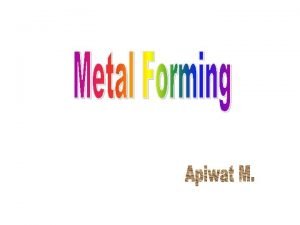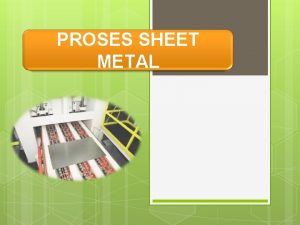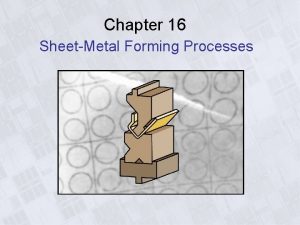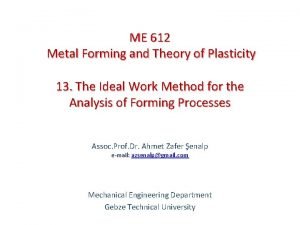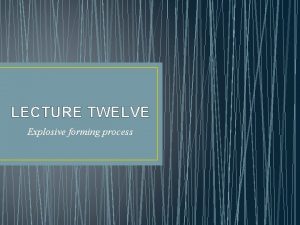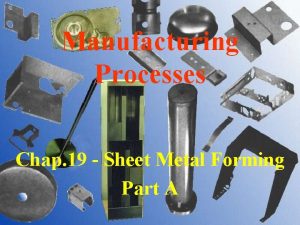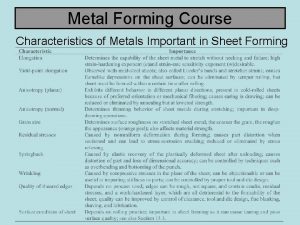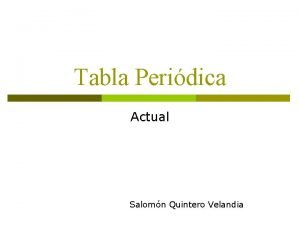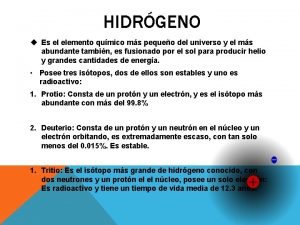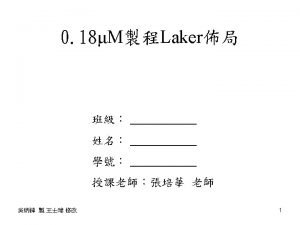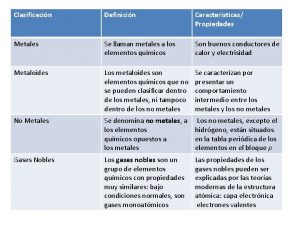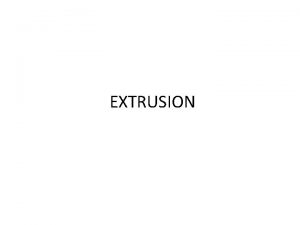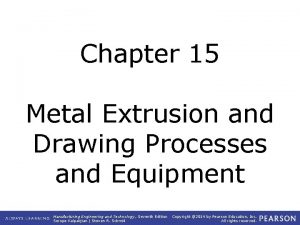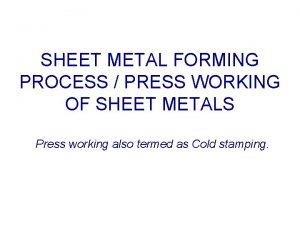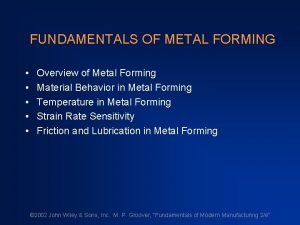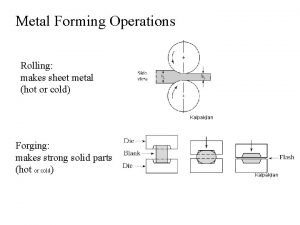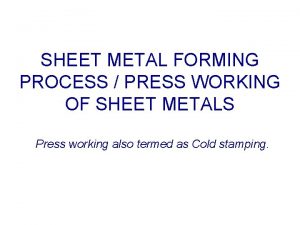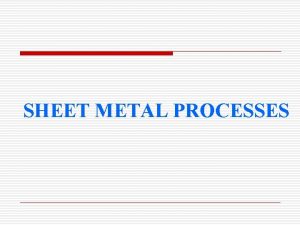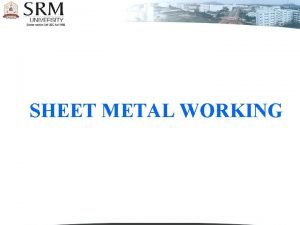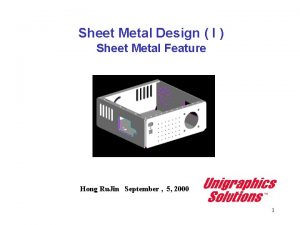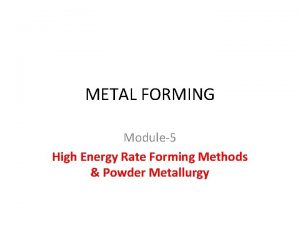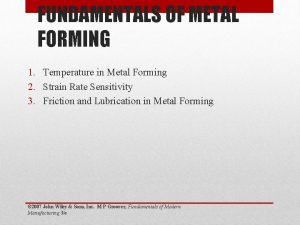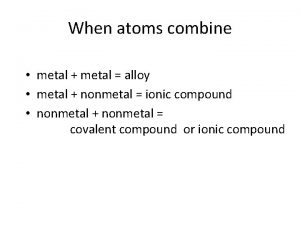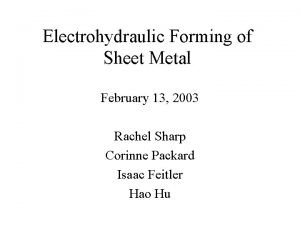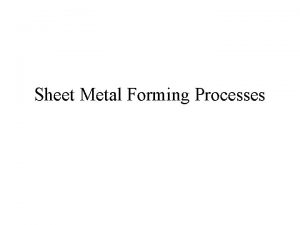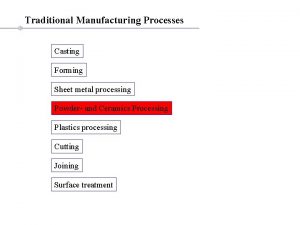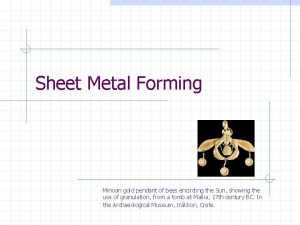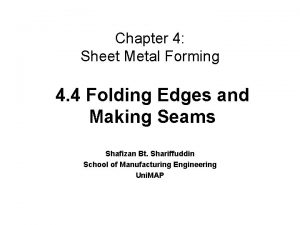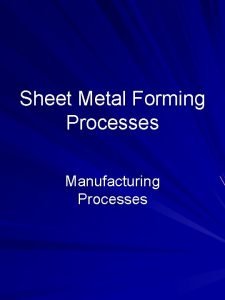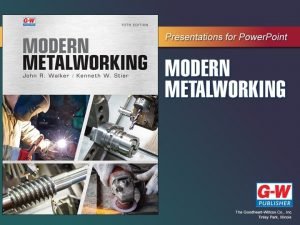L 8 Sheet metal forming Sheet Forming Sheet


























- Slides: 26

L 8: Sheet metal forming Sheet Forming

Sheet Forming as a System. L 8: Sheet metal forming The system variables affect the process and product quality 1. Workpiece / Blank 2. Tooling / Die Set 3. Tool/Mat’l Interface 4. Deformation Zone 5. Equipment / Press 6. Part / Product 7. Environment

Classification of Sheet Metal forming Processes L 8: Sheet metal forming Hemming Blanking Roll Forming Piercing Stretch Forming Trimming Bending Flanging Deep Drawing

Sheet Formed Parts L 8: Sheet metal forming

Failure in Sheet Metal Forming L 8: Sheet metal forming Issues • Material • Lubrication • Process design • Die design

Sheet Metal Characteristics L 8: Sheet metal forming • Elongation • Yield Point Elongation • Anisotropy • Grain size • Residual stresses • Springback • Wrinkling • Fracture and Cracking

Shearing Process with a Punch and Die L 8: Sheet metal forming Major variables • Punch force • Speed • Lubrication • Edge condition • Material (punch& die) • Corner radii • Clearance btw die and punch

Effect of clearance on shearing and micro-hardness L 8: Sheet metal forming C: Low C: High Clearance ranges between 2%- 10% of the sheet thickness

Shearing Load L 8: Sheet metal forming Approximate empirical formula for estimating the maximum punch load is, Pmax=0. 7 Sut. L Su= Ultimate Tensile Strength t = Sheet thickness L = Total length shear( for a circular hole L=p. D) D = Hole Diameter

Sheet Cutting Operations L 8: Sheet metal forming Punching: The sheared slug is discarded Blanking: The slug is the part and the rest is discarded

Progressive and Transfer Die L 8: Sheet metal forming Progressive Die: • The sheet metal is fed through a coil strip, and a different operation is performed at the same station with each stroke of a series of punches Transfer Die: • The sheet metal undergoes different operation at different stations. After each operation, the part is transferred to the next station for addition operation Progressive Die

Minimum Bending Radius L 8: Sheet metal forming Metal can only be bent so far before cracks form at the bend and, ultimately, the metal breaks • R: minimum bend radius T: Thickness r : reduction of area in tensile • When R/T=0: Complete bendability at a tensile reduction of 50%

Springback in bending L 8: Sheet metal forming Springback equation Rf: bend radius after springback RI: bend radius before springback Y: yield strength of the material E: modulus of elasticity of the material T: thickness of the material

Can Manufacture L 8: Sheet metal forming The metal-forming processes involved in manufacturing a two-piece aluminum beverage can.

Deep Drawing Process L 8: Sheet metal forming Significant Variables • Properties of sheet metal • Ratio of blank diameter to punch diameter • Sheet thickness • Clearance between the punch and the die • Punch and die and corner radii • Blankholder force • Friction and lubrication at the tool/workpiece interface • Speed of the punch

Deformation zone L 8: Sheet metal forming Flange Element: • High compressive stress in the tangential direction (σt) - Flange thickens • Blank holder applies load in the normal direction (σn) - Prevents wrinkling • Friction generates force in the radial direction (σr) Wall Element: • High tensile load, stretching in the radial direction (σr) • Unsupported region, no friction • Plane strain • Failure occurs near punch nose

Deep Drawing - Force Calculations L 8: Sheet metal forming Punch force: Dp =punch diameter t 0 = initial blank thickness Su =ultimate tensile strength of blank D 0 = initial blank diameter

Normal and Average Anisotropy L 8: Sheet metal forming Strains on a tensile-test specimen removed form a piece of sheet metal. These strains are used in determining the normal and planar anisotropy of the sheet metal.

Anisotropy and Isotropy L 8: Sheet metal forming

Deep Drawability (Limiting Drawing Ratio) L 8: Sheet metal forming The limiting drawing ratio (LDR) is the maximum ratio of blank diameter to punch diameter that can be drawn without failure, Do/Dp Effect of Average Anisotropy on LDR

Anisotropy and Isotropy L 8: Sheet metal forming

Interface : Friction L 8: Sheet metal forming • Friction occurs on the interface between both the blank and the punch as well as the blank and the die. • While some friction between the punch and the blank is essential for good drawability, too much friction increases the load.

Control of material flow by draw-bead L 8: Sheet metal forming Metal flow during drawing of a box-shaped part, using beads to control the movement of the material

Formability of materials L 8: Sheet metal forming Material formability is the ability of sheet metal to be formed without developing any failure. Formability tests: • Tensile test • Hydraulic bulge test • Cupping test • Forming-limit diagrams

Forming Limit Diagrams L 8: Sheet metal forming

Deformation and Tearing in Sheet Metal During Forming L 8: Sheet metal forming The deformation of the grid pattern and the tearing of sheet metal during forming. The major and minor axes of the circles are used to determine the coordinates on the forming-limit diagram. Source: After S. P. Keeler.
 Wholesale cold forming metal
Wholesale cold forming metal Casting forming and welding mcq
Casting forming and welding mcq Proses pembuatan sheet metal
Proses pembuatan sheet metal Forming process in sheet metal
Forming process in sheet metal Fundamentals of metal forming
Fundamentals of metal forming Theory of metal forming
Theory of metal forming Advantages of explosive forming
Advantages of explosive forming Hot working of metal is
Hot working of metal is Metal forming part
Metal forming part Draw bead
Draw bead Example of metal
Example of metal Melting point of diamond
Melting point of diamond Grupo b tabla periódica
Grupo b tabla periódica Venn diagram of solids liquids and gases
Venn diagram of solids liquids and gases Hidrgeno
Hidrgeno Non metals uses
Non metals uses 0 25
0 25 Dr terry blanch
Dr terry blanch Metals and non metals
Metals and non metals Pure substances on the periodic table
Pure substances on the periodic table Clasificación de oxigeno
Clasificación de oxigeno Periodic trends acidity
Periodic trends acidity Ionic compounds have
Ionic compounds have Multi-layers co-extrusion cast film die head
Multi-layers co-extrusion cast film die head Extrusion and drawing process
Extrusion and drawing process Press working process
Press working process Aluminum extrusion ratio formula
Aluminum extrusion ratio formula
